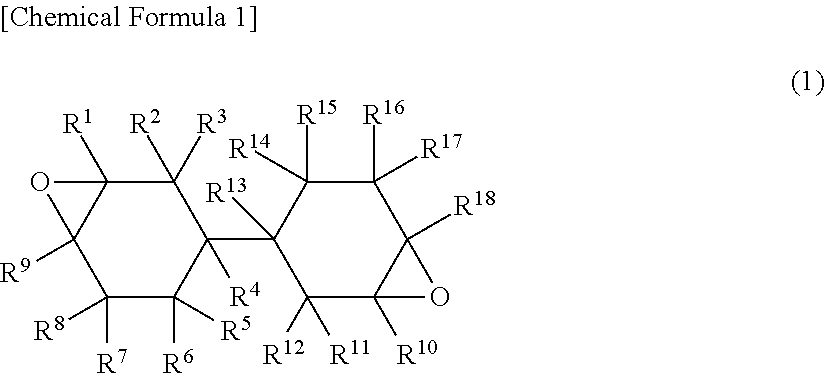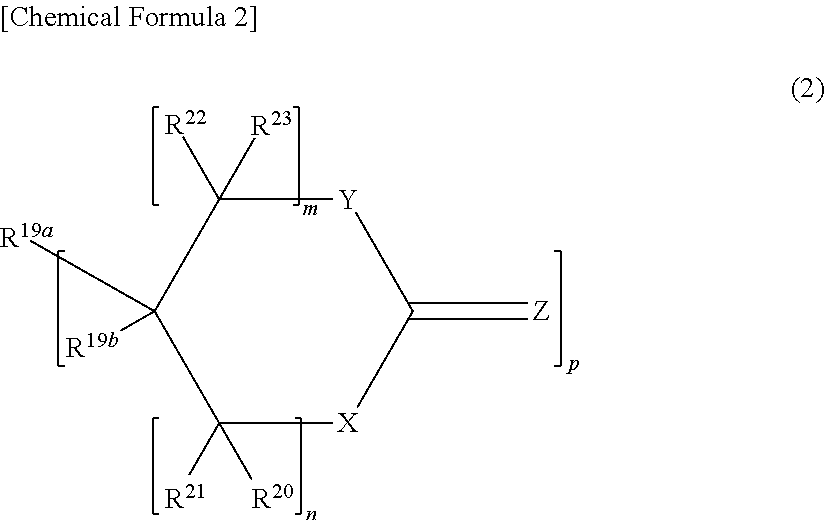Process for production of fine structure
a technology of fine structure and process, applied in the field of fine structure production, can solve the problems of cost explosion, microchip production, and rough surface of line edges, and achieve the effects of fine structure, less or no defects, and excellent pattern shap
- Summary
- Abstract
- Description
- Claims
- Application Information
AI Technical Summary
Benefits of technology
Problems solved by technology
Method used
Image
Examples
synthesis example 1
[0122]Nanoscale Particle Dispersion (E-1)
[0123]Acryloyloxypropyltrimethoxysilane (GPTS) (236.1 g; 1 mol) was refluxed with water (26 g; 1.5 mol) for 24 hours. Methanol generated by the reflux was removed at 70° C. using a rotary evaporator to obtain a GPTS condensate.
[0124]To the GPTS condensate was added 345 g of zirconium oxide (ZrO2; having an average particle diameter of 20 nm, and dispersed in methyl ethyl ketone with a ZrO2 concentration of about 5 percent by weight; supplied by Kitamura Chemicals Co., Ltd.) with stirring, and thereby yielded a nanoscale particle dispersion (E-1).
example 1
Film-Forming Aids (Binder Resins)
[0139]F-1: Copolymer of 3,4-epoxycyclohexylmethyl acrylate (CYCLOMER A400 supplied by Daicel Chemical Industries, Ltd.) and 1-ethyl-3-oxetanylmethyl methacrylate (product supplied by Toagosei Co., Ltd.)
[0140]F-2: Polyacrylate having free-radically polymerizable vinyl groups in the side chains; CYCLOMER P (ACA300) supplied by Daicel Chemical Industries, Ltd.
Solvents
[0141]G-1: Propylene glycol monomethyl ether acetate; MMPGAC supplied by Daicel Chemical Industries, Ltd.
[0142]
[0143]The compositions for nanoimprint were respectively formed into films coated on the silicon wafer through spin coating (at 3000 rpm, for 30 seconds). In the case of a composition containing a solvent, the coated film was dried at about 95° C. for 5 minutes to remove the solvent. The dry coated film after drying had a layer thickness of about 500 nm.
[0144]2) Transfer and Imprinting of Fine Structure onto Target Substrate
[0145]A fine structure was transferred and imprinted onto ...
PUM
| Property | Measurement | Unit |
|---|---|---|
| pressure | aaaaa | aaaaa |
| size | aaaaa | aaaaa |
| thickness | aaaaa | aaaaa |
Abstract
Description
Claims
Application Information
 Login to View More
Login to View More - R&D
- Intellectual Property
- Life Sciences
- Materials
- Tech Scout
- Unparalleled Data Quality
- Higher Quality Content
- 60% Fewer Hallucinations
Browse by: Latest US Patents, China's latest patents, Technical Efficacy Thesaurus, Application Domain, Technology Topic, Popular Technical Reports.
© 2025 PatSnap. All rights reserved.Legal|Privacy policy|Modern Slavery Act Transparency Statement|Sitemap|About US| Contact US: help@patsnap.com



